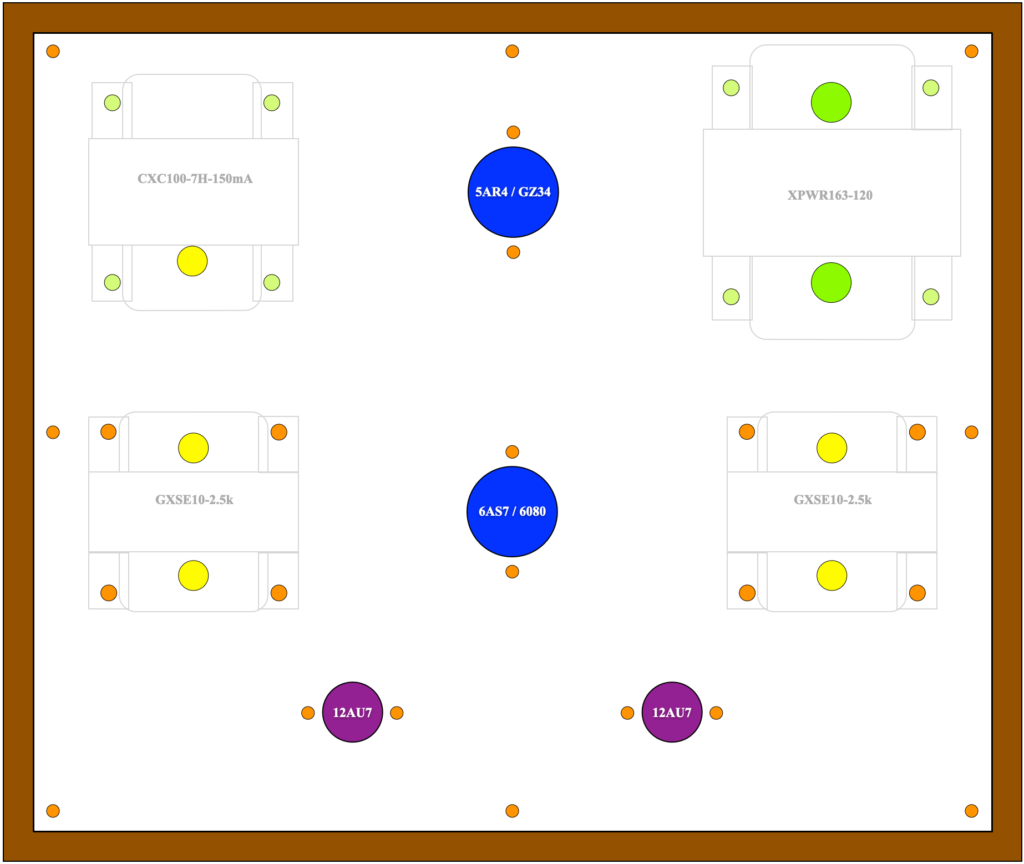As I discussed in my last post, there is a new SET amplifier on the horizon. This SET will sit midway in power and performance between the little SETs (6CY7, 6CY7 V2, and the 6EM7) and the big 6336 SET Amplifier.
After using all four of the other SETs for a while now, I decided a nice middle ground amplifier was in order. I wanted something with a little more power and presence than the little amplifiers and something not quite as physically large and heavy (as well as hot) as the big amplifier. For my approach, I decided to simply scale back the big 6336 project a little bit. I would keep the cascaded drivers that work so well for tubes with very low power sensitivity and utilize another series regulator tube, the 6AS7/6080 dual triode.
This tube has some good properties as a power tube. It has a 13W plate dissipation so I should be able to get a handful of watts in output power. The quiescent power dissipation will also be much lower than the 6336 amp, only ≈39W total in the power tube. This means that things should run much cooler than the big amp. Also, the 6AS7 does not require the long time to come to thermal stability like the big tube. This means that this amp will be better suited to shorter listening sessions and casual usage. And finally, the plate characteristics are such that the amplifier should produce a typically rich and full tone for which SETs are renowned.
This amp did kind of throw me as to the physical layout as I discussed in my last post. But I have finally settled on something a little more open than the 6336 amp but not quite as big as the 6V6 lacewood which has an 11″ by 14″ top plate. Here is my layout.
The top plate here is 12″ wide by 10″ deep. I have also gone for a symmetrical layout that leaves ample room around the tubes for both visibility and airflow. This is close in size to both the Marblewood 12-1/2″ by 9″ top plate and the 6336 12-1/2″ by 9-12″ top plate. However, this amp utilizes smaller transformers than the 6336 so it should’t look nearly as crowded.
Now that the layout is set, it’s time to do some internal layout and try to fine an appropriate piece of wood for the case. I’ll talk more about this new amplifier as the design progresses.


Pingback: 6AS7 SET is Completely Wired! | Cascade Tubes
Hi Matt, sorry I’m late to the party. I think I might have missed this post. I was wondering which path you would direct the speaker out wires to the speaker jacks. Would you be aiming to direct them away from the rectifier tube, power transformer and choke? And all the best for your retirement though it sounds like you will be as busy as ever.
In this design, the speaker leads run over to the left side of the top, then down the left side under the choke to the back. The signal inputs are on the far left behind the choke and the speaker lead just over toward the center from that. It’s almost impossible to get much coupling in the speaker leads from the power supply components, but there will still be ample separation. And I’ll twist everything to make sure to minimize the magnetic coupling.
Looks good!
A question – any advantage to rotating the output transformers 90 degrees to reduce magnetic coupling between them and the power transformer and filter choke? I’ve seen that done a lot on both factory built and homebrew amps.
I don’t believe so. I’ll make a few points of interest.
First, I have never had a coupling problem while using Edcor transformers with end bells. Even in amps like the 6CY7 V2 where the output transformer is side by side with the power transformer and the o/p transformer core gap is facing the power transformer. Edcor takes their magnetic circuit design seriously.
Second, these transformers are front to back. This puts the magnetic shielding toward the other transformer and places the core gaps to the right. Leakage coupling should be very small or non-existent in this configuration. Most magnetic flux leakage in these transformers is along the core gap. So long as the gaps are not aligned and close to each other it should be ok.
Third, I have had a minor issue when using the older XPWR024 which was open frame in the 6DJ8 Push-Pull Headphone amp. However this was manageable. And Edcor has since upgraded the XPWR024 to an end bell configuration. So with open frame magnetics, this can be an issue.
Finally, I know that this can make a real difference, especially when using lower quality magnetics and those with open frames. I should point out that the entire purpose of the closed frame transformer is to reduce magnetic flux leakage. In some DIY kits with open magnetics (most notably the old S-5, K-8, and K-12 amplifier kits) transformer rotation can make a large difference. However, when using higher quality closed frame magnetics, so long as core gaps are not placed in close proximity to each other, magnetic coupling should not be an issue.